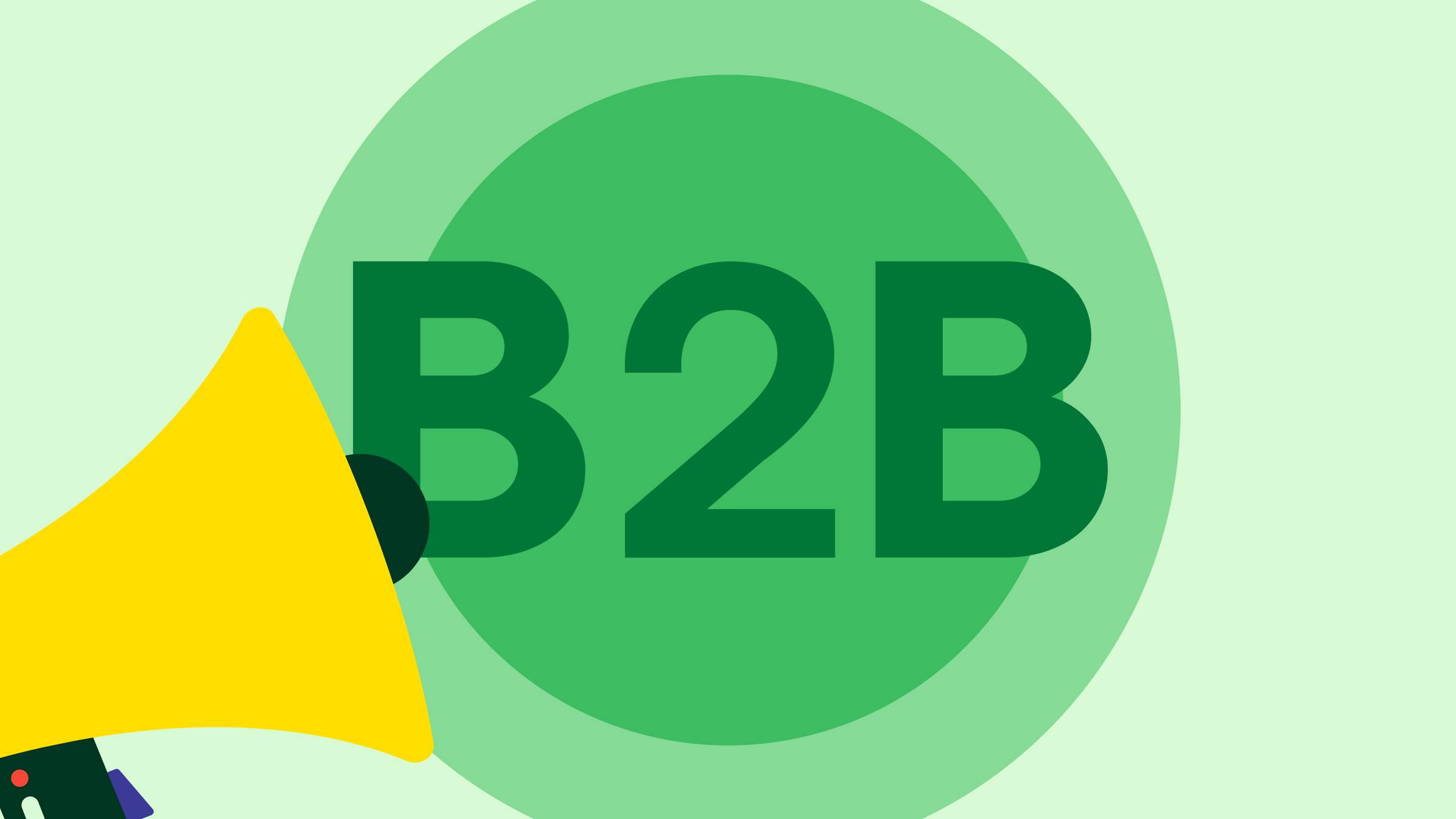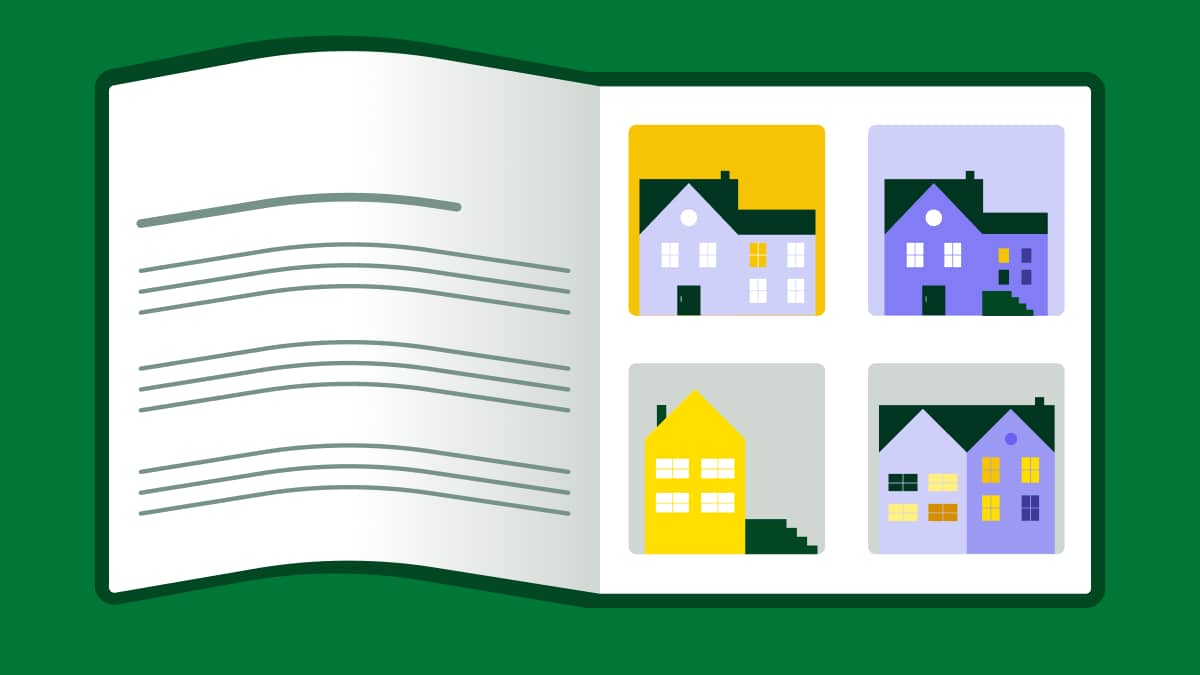Attracting customers is nearly impossible without a well-planned marketing funnel. However, creating your own as a small to medium-sized business isn’t one-size-fits-all.
In this article, you’ll learn how to build a digital marketing funnel that consistently brings in new prospects, leads and customers.
What is a marketing funnel?
A marketing funnel describes the customer journey from initial brand awareness to purchase decision and advocacy.
It helps your SMB guide prospects through each stage of that journey with targeted content and messaging that meets their specific needs.
The goal is to increase sales by offering the right message at the right time. When prospects see tailored messaging that addresses their pain points, they’re more likely to trust your brand and take action.
Importantly, marketing funnels aren’t one-size-fits-all. Each business will shape its funnel based on its product, audience and buying cycle.
However, most split that journey into three distinct stages (top, middle and bottom of the funnel):

For example, a startup that offers project management software might focus on the following at each stage:
Top of funnel (TOFU). Blog posts and social posts that answer common productivity questions and attract traffic.
Middle of funnel (MOFU). Downloadable guides, webinars and email campaigns that explain how to choose the right project management tool or show comparisons.
Bottom of funnel (BOFU). Testimonials, case studies and limited-time offers that help prospects feel confident and ready to buy.
Meanwhile, a luxury travel agency might lean more on Instagram and video at the top, consultations in the middle and personal concierge support to close deals.
By mapping out a funnel tailored to your unique customer journey, you can better prioritize resources and improve results at every stage.
Marketing funnel vs. sales funnel vs. conversion funnel
The terms marketing funnel, sales funnel and conversion funnel are often used interchangeably in online marketing. However, they have distinct purposes.
Here’s how different teams use each type of funnel:
Type of funnel | Its purpose |
Marketing funnel | Outlines how marketing teams attract and nurture potential customers through content, ads and campaigns |
Sales funnel | Outlines how sales teams turn leads you’ve already attracted into paying customers through outreach, product demos and proposals |
Conversion funnel | Outlines how cross-functional departments (including sales, marketing and product teams) optimize specific actions (e.g., signing up or booking a demo), often within a landing page or digital flow |
Each funnel plays a different role, but they all work best when aligned across the full customer experience (CX).
For example, the marketing funnel creates brand awareness through content marketing. It builds interest, trust and an emotional connection with potential customers.
Capturing contact information and qualifying interest during these stages enables the sales team to engage promising leads with relevant outreach. The final stage is usually a purchase or conversion, but some marketing funnels include additional activities, like upselling and cross-selling.
The sales funnel takes over when someone is interested but not quite ready to commit. For business-to-business (B2B) buying decisions with more stakeholders and longer sales cycles, it includes stages like personal engagement and negotiation.
The sales cycle also continues beyond closing the deal to include account management.
Note: Many businesses use customer relationship management (CRM) funnels to track prospects through the marketing and sales funnel stages. These overviews ensure marketing, sales and customer data stay connected and actionable.
Finally, the conversion funnel optimizes specific actions like downloads or purchases within the marketing and sales processes.
It helps turn interest into measurable results by refining the user journey and removing friction.
Top, middle and bottom: the structure of a digital marketing funnel
The top of the marketing funnel builds awareness, the middle nurtures interest and the bottom drives action or conversion. However, the stages within this framework can vary, so not all funnels look the same.
For example, while some companies follow the AIDA model (attention, interest, desire and action), others may prefer REAN (reach, engage, activate and nurture). Others may follow a different model altogether.
Whatever fits your business best, all marketing funnel stages tend to start broad at the top and narrow down:
Top of funnel | Your brand captures the potential customer’s attention |
Middle of funnel | The potential customer expresses interest and begins to desire your product |
Bottom of funnel | The customer takes action by purchasing (and/or the marketing funnel becomes a sales funnel) |
Let’s look more closely at each specific stage of the marketing funnel.
Top of the funnel: awareness stage
TOFU (the awareness stage) is about capturing prospective customers’ attention. This phase is someone’s first contact with your company.
Here, you show that you understand their challenges and needs and help them understand why your topics and products are relevant.
For example, a social media ad promoting a free webinar is typically a TOFU element that attracts attention and new leads.
It’s on a social platform (broad reach), offers free value (low barrier) and is aimed at people who might not know about your brand yet.
Possible content formats for TOFU include:
Search engine optimization (SEO)-driven blog articles on introductory topics
Podcasts
Facebook, Instagram and LinkedIn ads
Outdoor advertising
Webinars
Your goal at the top of the funnel is to build brand awareness and generate leads that will pay off later.
Middle of the funnel: consideration stage
MOFU (the consideration stage) involves spurring interest in your offerings and building trust. You achieve this by creating valuable content that provides helpful solutions and introduces products that meet prospects’ challenges.
For example, you could send a lead-nurturing email sequence to those who attended your free webinar.
On this owned channel, you can deliver more in-depth, high-quality content that addresses specific pain points. You’ll also demonstrate expertise and consistent value, which increases credibility.
Possible content formats for MOFU include:
SEO-driven blog articles, like tool comparisons or how-to guides
Lead magnets such as e-books, checklists or whitepapers
Email marketing sequences
Webinars on specific topics (e.g., a deeper dive)
Landing pages
Case studies
In this stage, you engage and inform prospects to move them closer to a purchase decision (without being pushy).
Bottom of the funnel: decision stage
BOFU (the decision-making or purchase stage) involves answering questions about your products and addressing possible concerns. Here, leads are seriously thinking about buying.
The final stage is about building confidence and giving people the final nudge to convert. You show why your solution is the right choice and make it simple to move forward.
For example, you could follow up your email nurture sequence with a powerful testimonial or a limited-time discount at checkout to prompt action.
Possible content formats for BOFU include:
Product trials or demos
Tutorials and walkthroughs
Product fact sheets with pricing information
Sales events
Testimonials
Your goal here is to help leads feel fully informed, supported and ready to make a purchase decision.
Note: BOFU also lays the groundwork for long-term loyal customers. A strong final impression (through helpful support, transparent pricing and social proof) can increase the chances of repeat business and brand advocates down the line.
5 steps to creating your own successful online marketing funnel
Every business and marketing funnel is different. Yours must reflect your unique purchasing process, customer touchpoints and how your audience makes decisions.
For example, a local fitness studio might rely heavily on Instagram influencers and referrals. On the other hand, a software-as-a-service (SaaS) company may focus on SEO, webinars and email nurture sequences.
Both have top, middle and bottom stages, but the execution looks very different.
Follow these five steps to build a funnel strategy that fits your business needs and converts.
1. Define your goal
A clear goal helps you focus your marketing funnel’s content, targeting and metrics. SMBs often have limited resources. By prioritizing efforts that move the needle, you’ll avoid spreading your budget and team too thin.
Start by asking yourself:
What’s the primary objective of our funnel (e.g., to generate leads, sell a product or book consultations)?
What does success look like in numbers (e.g., 500 qualified leads or 100 monthly sales)?
How will we measure progress at each stage of the funnel?
Define what success looks like for you and how you’ll measure each milestone. For example:
"We want to generate 250 new qualified leads and make 50 sales a month.”
To choose your own goal:
Pick one high-impact business goal to anchor your funnel
Turn that goal into a measurable target (include timeframe and metrics)
Use this goal to guide decisions around content, platforms and budget allocation
This step keeps everything aligned so your funnel doesn’t just look good, it delivers real results.
2. Identify your target audience
Identifying your target audience ensures your funnel attracts the right people and speaks to their challenges and motivations. You’ll focus your marketing efforts where they’ll have the biggest impact and avoid burning resources on prospects who aren’t a good fit.
For example, a bookkeeping software provider might target freelancers looking for simple, low-cost solutions and SMB owners who want robust reporting and integrations.
By identifying each group’s distinctions early, the company can tailor its messaging, content and funnel stages to resonate with each segment.
By conducting an audience analysis, you can define buyer personas and ideal customer profiles (ICPs) to learn demographics, needs and preferences.
Think about your ideal customers. What problems are they trying to solve, and where do they spend time online?
Here are some more questions you can ask to build your personas:

The goal is to build accurate profiles based on real customer data. Here are four tips to collect and store useful data:
Conduct short interviews or customer surveys to gather first-hand feedback
Read social posts and reviews to learn more about the people using your products
Use tools like Google Analytics, social media insights or database records to spot trends
Store your findings in a CRM tool like Pipedrive to keep everyone aligned on who you’re targeting
When you understand your audience deeply, you can create messaging that resonates and design a funnel that guides them naturally toward your solution.
3. Map your customer journey
Mapping the customer journey helps you visualize the steps people take (from first discovery to final decision) and where your brand fits in.
It also determines the structure of your marketing funnel, which should represent every type of customer and touchpoint that fits your business.
With a clear journey, you’ll send the right message at the right time to match key moments. For example, a fitness coach might discover that clients often follow them on TikTok before signing up for a free consultation.
That touchpoint becomes an important early-stage trigger in the funnel and an opportunity to guide prospects more intentionally.
Here’s how to discover your key touchpoints:
Use customer behavior tools like Google Analytics or heatmaps to see how people find and navigate your website
Ask existing customers how they first heard about you and what steps they took before purchasing
Check your CRM system or sales notes for common patterns in how leads move through your sales pipeline
Look at attribution reports from email, paid ads and e-commerce platforms to trace conversion paths
Map out internal processes to identify where your team interacts with customers (e.g., emails, demos or live chat support)
Once you have this information, use this Pipedrive template to visualize each customer type and how they interact with you at each journey stage:

A well-mapped customer journey helps you streamline funnel design, meet people where they are and lead them where you want them to go.
Download our customer journey map template
4. Outline your marketing funnel and create content
Design a content marketing funnel that supports your customer journey. Consider what resources would best support people at each touchpoint and prompt them to act.
Your funnel should align with the TOFU/MOFU/BOFU model to attract attention, nurture interest and convert leads into customers.
Each stage needs relevant marketing campaigns that answer real questions, solve pain points and nudge prospects closer to a decision.
Let’s say your audience discovers you through search. You might create:
SEO-driven blog posts (TOFU)
An email guide on how to compare options (MOFU)
A testimonial or free trial offer to close the sale (BOFU)
Instead of creating content for every channel simultaneously, this approach helps your small team focus on key moments in the buyer’s journey. It also makes your marketing more intentional and easier to track.
Here’s how to design your marketing funnel:
Sketch a simple funnel diagram with TOFU, MOFU and BOFU stages
Choose 1–2 content formats per stage (e.g., guides for TOFU and comparison landing pages for BOFU)
Create content that speaks directly to customer pain points and goals
Add clear calls-to-action (CTAs) to move people to the next stage
Share content across your most relevant marketing channels (e.g., your website, email and social media platforms)
This step turns your marketing strategy into execution, so the funnel that looks good on paper actually works.
5. Analyze and optimize your funnel
Review your funnel’s data and performance metrics regularly (e.g., conversion and retention rates) to identify what’s working and where there’s room for improvement.
For example, small changes (like a stronger call-to-action or a clearer email subject line) can make a big difference.
Optimization helps you stretch your marketing dollars and steadily increase your return on investment (ROI).
Think about:
Where are people dropping off in the funnel?
Which channels or content pieces drive the most conversions?
Are you meeting your goals at each stage?
To answer these questions, review funnel metrics regularly (e.g., click-through rates, traffic, email opens and lead quality). Use CRM dashboards, analytics tools and email platforms for insights.
Work systematically to improve each stage. Run small A/B tests on one element at a time (e.g., a heading or CTA) to track which changes boost performance.
Collect customer feedback to uncover more friction points or unclear messaging. Have a mindset of data-driven improvement to determine what works best for your company and its goals.
How to build different types of CRM funnels for marketing in Pipedrive
Pipedrive makes building and managing CRM funnels tailored to your specific marketing goals easy. For example, you can create a re-engagement or lead generation funnel.
Turning your marketing funnel into a custom pipeline inside your CRM allows you to track progress, automate tasks and improve conversion rates at every stage.
Start by defining your funnel’s purpose (e.g., following up with leads after a webinar) and create a new Pipedrive pipeline that reflects that journey.
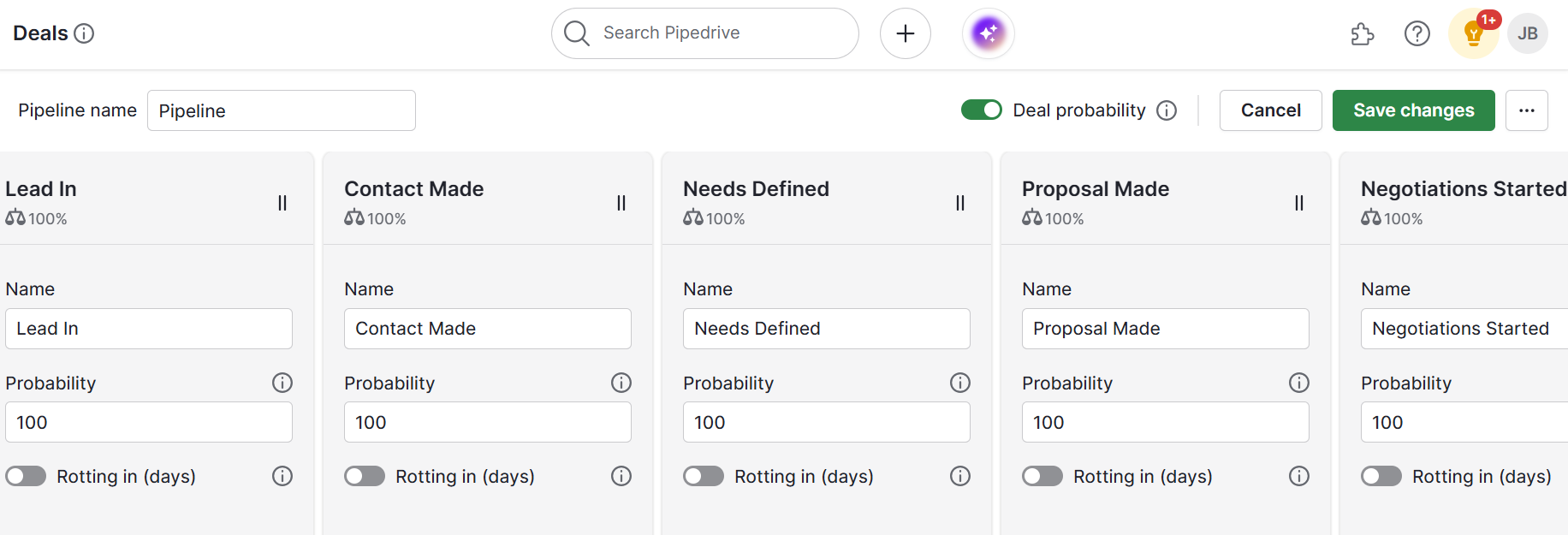
Map out the key steps in that specific customer group’s journey. For example, the webinar funnel stages may include “Registered”, “Attended or missed”, “Engaged with follow-up”, “Qualified lead”, “Handed to sales” and “Converted”.
Set up marketing automations to move contacts or deals forward automatically based on actions (like submitting a form or opening an email), so nothing falls through the cracks.
Here’s where workflow automations live in Pipedrive:
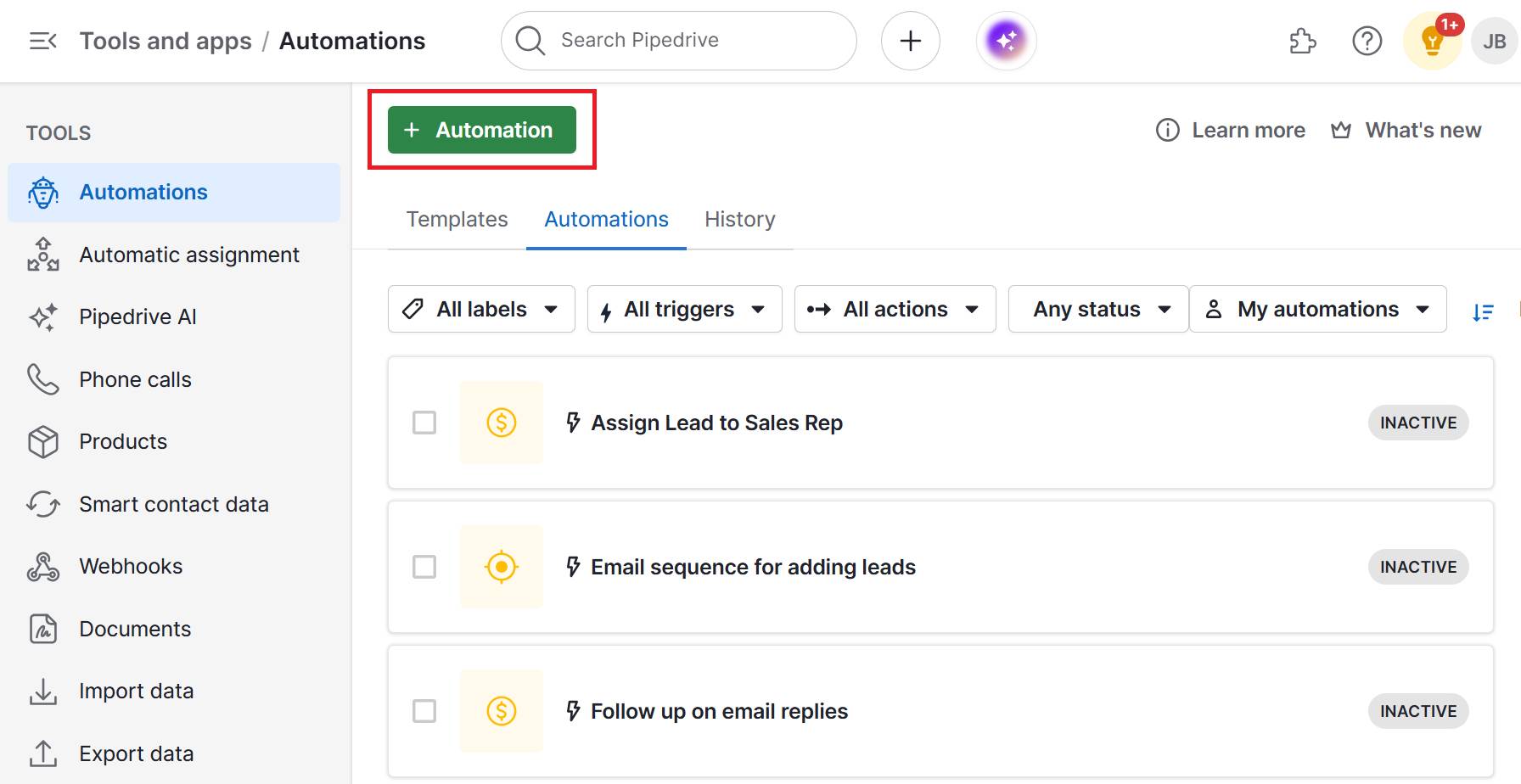
Connect your website forms, landing pages and ad platforms to Pipedrive so new leads flow directly into the funnel without manual entry.
You can use Marketplace integrations or add-ons like Web Forms for this:
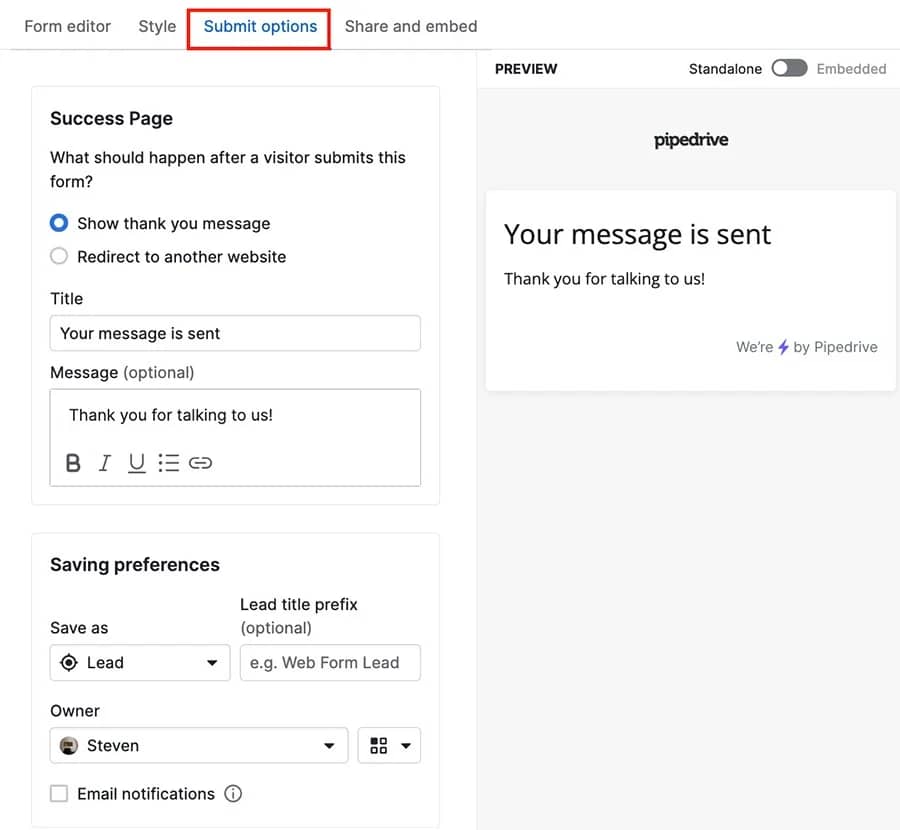
When everything’s set up, Pipedrive’s real-time reporting helps you monitor conversion rates between stages.
Identify where leads drop off, refine your messaging to fix bottlenecks and improve customer satisfaction:
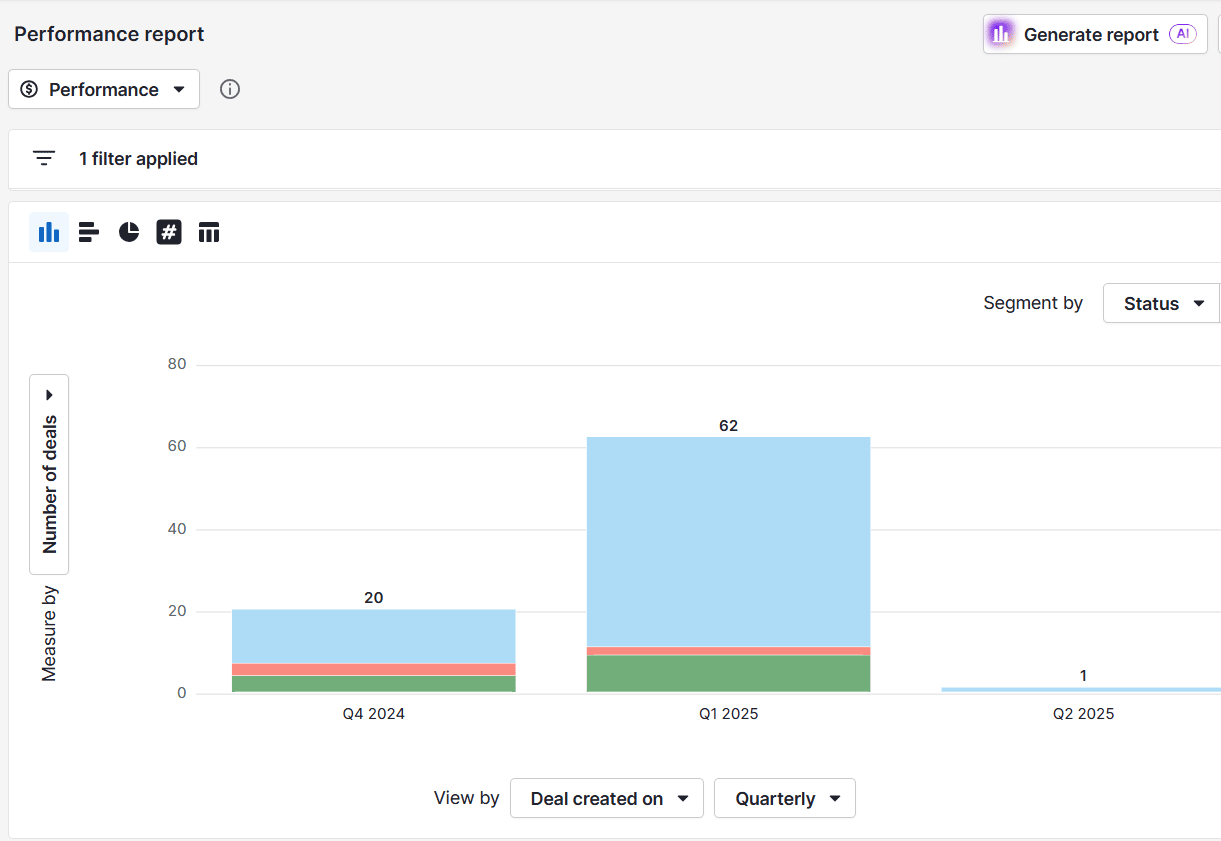
Combining lead management and marketing funnels inside an all-in-one CRM system keeps everything organized, measurable and actionable.
Final thoughts
A well-constructed marketing funnel ensures your small business remains competitive and continues to attract new customers. Yours should reflect your unique audience, sales process and customer touchpoints.
You need the right software to build and track a funnel that fits your business. Try Pipedrive free for 14 days to test its custom pipelines, automations and real-time insights, learn what works for your team and grow with confidence.


